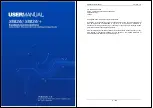
SIP User's Manual
382
Document #: LTRT-68808
Mediant
2000
Notes:
•
STUN only applies to UDP (doesn’t support TCP and TLS).
•
STUN can’t be used when the device is located behind a symmetric NAT.
•
Use either the STUN server IP address (STUNServerPrimaryIP) or
domain name (STUNServerDomainName) method, with priority to the
first one.
8.3.2
First Incoming Packet Mechanism
If the remote device resides behind a NAT device, it’s possible that the device can activate
the RTP/RTCP/T.38 streams to an invalid IP address / UDP port. To avoid such cases, the
device automatically compares the source address of the incoming RTP/RTCP/T.38 stream
with the IP address and UDP port of the remote device. If the two are not identical, the
transmitter modifies the sending address to correspond with the address of the incoming
stream. The RTP, RTCP and T.38 can thus have independent destination IP addresses and
UDP ports.
You can disable the NAT mechanism by setting the
ini
file parameter DisableNAT to 1. The
two parameters EnableIpAddrTranslation and EnableUdpPortTranslation allow you to
specify the type of compare operation that occurs on the first incoming packet. To compare
only the IP address, set EnableIpAddrTranslation to 1, and EnableUdpPortTranslation to 0.
In this case, if the first incoming packet arrives with only a difference in the UDP port, the
sending addresses won’t change. If both the IP address and UDP port need to be
compared, then both parameters need to be set to 1.
8.3.3
No-Op Packets
The device's No-Op packet support can be used to verify Real-Time Transport Protocol
(RTP) and T.38 connectivity, and to keep NAT bindings and Firewall pinholes open. The
No-Op packets are available for sending in RTP and T.38 formats.
You can control the activation of No-Op packets by using the
ini
file parameter
NoOpEnable. If No-Op packet transmission is activated, you can control the time interval in
which No-Op packets are sent in the case of silence (i.e., no RTP or T.38 traffic). This is
performed using the
ini
file parameter NoOpInterval. For a description of the RTP No-Op
ini
file parameters, refer to ''Networking Parameters'' on page
RTP No-Op:
The RTP No-Op support complies with IETF’s draft-wing-avt-rtp-noop-
03.txt (titled ‘A No-Op Payload Format for RTP’). This IETF document defines a No-Op
payload format for RTP. The draft defines the RTP payload type as dynamic. You can
control the payload type with which the No-Op packets are sent. This is performed
using the RTPNoOpPayloadType
ini
parameter (refer to ''Networking Parameters'' on
page
). AudioCodes’ default payload type is 120.
T.38 No-Op:
T.38 No-Op packets are sent only while a T.38 session is activated. Sent
packets are a duplication of the previously sent frame (including duplication of the
sequence number).
Note:
Receipt of No-Op packets is always supported.
Summary of Contents for Mediant 2000
Page 1: ...Document LTRT 68808 November 2008 User s Manual Version 5 6 ...
Page 2: ......
Page 18: ...SIP User s Manual 18 Document LTRT 68808 Mediant 2000 Reader s Notes ...
Page 254: ...SIP User s Manual 254 Document LTRT 68808 Mediant 2000 Reader s Notes ...
Page 334: ...SIP User s Manual 334 Document LTRT 68808 Mediant 2000 Reader s Notes ...
Page 342: ...SIP User s Manual 342 Document LTRT 68808 Mediant 2000 Reader s Notes ...
Page 408: ...SIP User s Manual 408 Document LTRT 68808 Mediant 2000 Reader s Notes ...
Page 414: ...SIP User s Manual 414 Document LTRT 68808 Mediant 2000 Reader s Notes ...
Page 418: ...User s Manual Version 5 6 www audiocodes com ...
















































